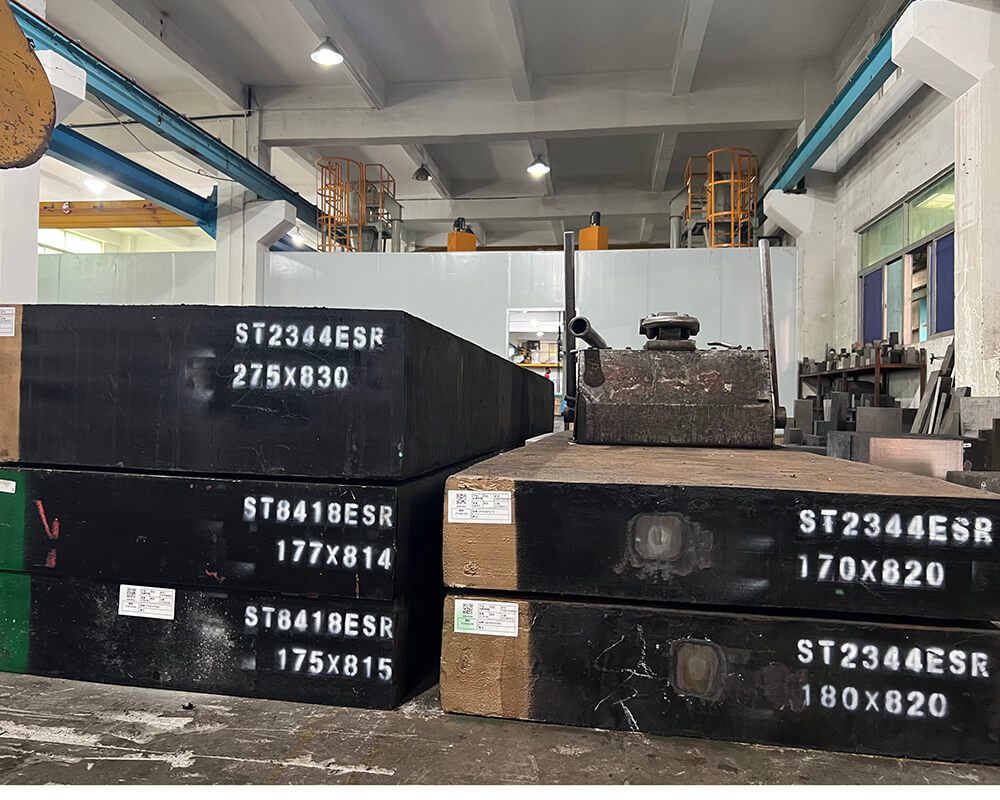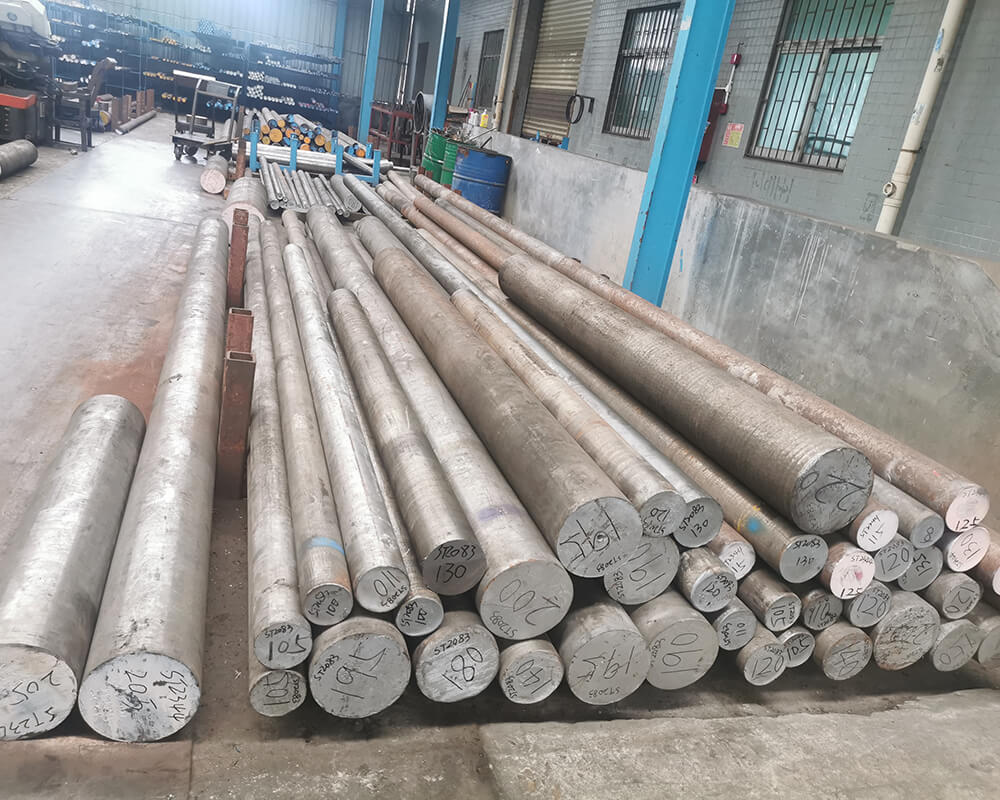
mold steel
Mold steels are chosen for their ability to withstand the high mechanical and thermal stresses encountered during the molding and forming processes. Here are some key characteristics and common applications of mold steel:
Characteristics:
Wear Resistance: Mold steels have excellent wear resistance to withstand the abrasive nature of molding materials.
Dimensional Stability: They maintain dimensional stability and precision, ensuring the accuracy of the molded or stamped parts.
Heat Resistance: Mold steels can withstand elevated temperatures and thermal cycling without deformation or cracking.
Polishability: Some mold steels have good surface finish and polishability, which is crucial for producing high-quality molded parts with smooth surfaces.
Corrosion Resistance: Mold steels are often designed to resist corrosion, as molds and dies can be exposed to moisture and chemicals.
Machinability: Good machinability allows for ease of fabrication and tool manufacturing.
Application
Plastic Injection Molding: Mold steel is used to make molds for plastic injection molding, a process for producing plastic parts and products.
Die Casting: Die casting molds, which are used to create metal parts through high-pressure injection, are typically made from mold steel.
Stamping and Forming: Mold steel is used for stamping dies and forming tools used in industries like automotive, aerospace, and consumer goods manufacturing.
Extrusion: Extrusion dies, used in the production of materials like aluminum profiles, are often made from mold steel.
Blow Molding: Mold steel is used to create molds for blow molding processes, commonly used for manufacturing plastic bottles and containers.
Compression Molding: Mold steel is used for compression molding dies used in the production of composite materials and rubber parts.
Glass Molding: Some mold steels are designed for glass molding applications, such as manufacturing glass lenses and optical components.
Rubber Molding: Mold steel is used to create molds for rubber compression and injection molding processes.
Powder Metallurgy: In powder metallurgy, mold steel is used to make tooling for compacting and shaping metal powders into components like gears, bearings, and bushings.
Coin Minting: Mold steel is used to create coin dies and stamps in coin minting operations, ensuring the production of high-quality coins and currency.
Precision Cutting Tools: Some mold steels are used for manufacturing precision cutting tools such as taps, drills, reamers, and milling cutters, crucial in the machining and metalworking industries.
Cold Rolling: Mold steel is used in the manufacture of rolls for cold rolling mills, employed to reduce the thickness of metal sheets and produce smooth surfaces.

WE OFFER
| Steel Type | GERMANY | AISI | Sweden | JAPAN | FUSHUN | Grade | Hardness HB or HRC | Ultrasonic TEST | Hot rolled plate sizes range | Hot forged plate and block sizes range | Round bar sizes range |
| Plastic Mould Steel | 1.2311 | P20 | — | SCM440 | — | 1.2311/P20 | Pre-hardened 28-34HRC | Sep1921-84 D/d | Thick 20-250mm x Width 1800-2300mm | Thick 200-850mm x Width 800-1600mm | Black surface Dia.20-200mm |
| 1.2738 | P20+Ni | 718 | HPM7/PX5 | FS838/FS838H | 1.2738 | Pre-hardened 33-38HRC | Sep1921-84 E/e | Thick 10-150mm x Width 1800-2300mm | Thick 200-1050mm x Width 800-1600mm | Black surface Dia.20-200mm | |
| — | P21Mod ESR | — | NAK80 | — | NAK80 | Pre-hardened 38-42HRC | Sep1921-84 D/d | Thick 20-90mm x Width 200-610mm | Thick 100-500mm x Width 500-1200mm | Machined Dia 20-200mm | |
| 1.2083 | 420 | — | — | FT64 | 1.2083/420 | Annealed ≤230HB | Sep1921-84 D/d | Thick 20-120mm x Width 200-810mm | Thick 100-500mm x Width 500-1200mm | Machined Dia 20-300mm | |
| 1.2083 ESR | 420 ESR | STAVAX | S-STAR | FS136 | 1.2083 ESR | Annealed ≤230HB | Sep1921-84 D/d | Thick 20-90mm x Width 200-810mm | Thick 100-500mm x Width 500-1200mm | Machined Dia 20-300mm | |
| 1.2085 | 420+S | ROYALLOY | HMP77/G-STAR | — | 1.2085 | Annealed≤230HB Pre-hardened 30-36HRC | Sep1921-84 E/e | Thick 20-90mm x Width 200-810mm | Thick 100-500mm x Width 500-1200mm | ||
| 1.2316 | — | — | HPM38/PAK90 | — | 1.2316 | Annealed≤230HB Pre-hardened 30-36HRC | Sep1921-84 E/e | Thick 20-90mm x Width 200-810mm | Thick 100-400mm x Width 500-1200mm | ||
| 1.2343 | H11 | — | — | FT2343 | 1.2343/H11 | Annealed ≤230HB | Sep1921-84 E/e | Thick 20-90mm x Width 200-305mm | Thick 100-400mm x Width 500-1000mm | ||
| 1.2343 ESR | H11 ESR | VIDARS | — | FT2343 ESR | 1.2343 ESR/H11 ESR | Annealed ≤230HB | Sep1921-84 E/e | Thick 20-90mm x Width 200-305mm | Thick 100-800mm x Width 500-1200mm | ||
| 1.2344 | H13 | 8402 | SKD61 | FS413 | 1.2344/H13 | Annealed ≤230HB | Sep1921-84 E/e | Thick 20-90mm x Width 200-610mm | Thick 100-500mm x Width 500-1200mm | Machined Dia 20-200mm | |
| 1.2344 ESR | H13 ESR | 8407 SUPREME | DHA1-A | FS413 ESR | 1.2344 ESR/H13 ESR | Annealed ≤230HB | Sep1921-84 E/e | Thick 20-90mm x Width 200-610mm | Thick 100-500mm x Width 500-1200mm |
Wear Resistance: Mold steels have excellent wear resistance to withstand the abrasive nature of molding materials.
Dimensional Stability: They maintain dimensional stability and precision, ensuring the accuracy of the molded or stamped parts.
Heat Resistance: Mold steels can withstand elevated temperatures and thermal cycling without deformation or cracking.
Polishability: Some mold steels have good surface finish and polishability, which is crucial for producing high-quality molded parts with smooth surfaces.
Corrosion Resistance: Mold steels are often designed to resist corrosion, as molds and dies can be exposed to moisture and chemicals.
Machinability: Good machinability allows for ease of fabrication and tool manufacturing.
Common Applications:
Plastic Injection Molding: Mold steel is used to make molds for plastic injection molding, a process for producing plastic parts and products.
Die Casting: Die casting molds, which are used to create metal parts through high-pressure injection, are typically made from mold steel.
Stamping and Forming: Mold steel is used for stamping dies and forming tools used in industries like automotive, aerospace, and consumer goods manufacturing.
Extrusion: Extrusion dies, used in the production of materials like aluminum profiles, are often made from mold steel.
Blow Molding: Mold steel is used to create molds for blow molding processes, commonly used for manufacturing plastic bottles and containers.
Compression Molding: Mold steel is used for compression molding dies used in the production of composite materials and rubber parts.
Glass Molding: Some mold steels are designed for glass molding applications, such as manufacturing glass lenses and optical components.
Rubber Molding: Mold steel is used to create molds for rubber compression and injection molding processes.
Powder Metallurgy: In powder metallurgy, mold steel is used to make tooling for compacting and shaping metal powders into components like gears, bearings, and bushings.
Coin Minting: Mold steel is used to create coin dies and stamps in coin minting operations, ensuring the production of high-quality coins and currency.
Precision Cutting Tools: Some mold steels are used for manufacturing precision cutting tools such as taps, drills, reamers, and milling cutters, crucial in the machining and metalworking industries.
Cold Rolling: Mold steel is used in the manufacture of rolls for cold rolling mills, employed to reduce the thickness of metal sheets and produce smooth surfaces.
Common grades of mold steel include P20, H13, S7, and 420 stainless steel, among others. The choice of mold steel grade depends on factors such as the type of material being molded, the required surface finish, the expected production volume, and the desired tool life.
Mold steel is critical in ensuring the quality and precision of the manufactured parts, making it a key component in various manufacturing industries.
Mold steel, also known as mold tool steel or mold-making steel, includes various grades and types of steel that are used for making molds, dies, and tooling for industrial processes like plastic injection molding, die casting, and stamping. While mold steel grades are often referred to by their standard designations rather than the AISI (American Iron and Steel Institute) system, here are a few common mold steel grades along with their equivalent AISI designations where applicable:
AISI P20 (also known as DIN 1.2311): AISI P20 is a widely used mold steel known for its excellent machinability, good polishability, and good wear resistance. It is often used in plastic injection molding and die casting applications.
AISI H13 (also known as DIN 1.2344): AISI H13 is a hot work tool steel with excellent heat resistance, wear resistance, and toughness. It is commonly used for die casting molds, extrusion dies, and hot forging dies.
AISI S7 (also known as DIN 1.2357): AISI S7 is a shock-resistant tool steel with good toughness and wear resistance. It is used for applications where impact resistance is critical, such as in stamping and forming dies.
AISI 420 (also known as DIN 1.2316): AISI 420 is a stainless mold steel with good corrosion resistance. It is often used for molds that require resistance to corrosion, such as those used in food processing or medical device manufacturing.
AISI D2 (also known as DIN 1.2379): AISI D2 is a high-carbon, high-chromium cold work tool steel with excellent wear resistance. While it is more commonly used for cutting tools, it can also be used for certain mold and die applications.
Please note that the designation and naming conventions for mold steel can vary by region and industry. The mentioned AISI designations are provided for reference, but it’s important to refer to specific industry or international standards for precise specifications and designations when selecting mold steel for a particular application.
The choice of mold steel grade depends on factors such as the molding process, material to be molded, expected production volume, and desired tool life.
Various countries and regions use their own classification systems and designations for mold steel, which may differ from the AISI (American Iron and Steel Institute) system commonly used in North America.
These classification systems are established by national or international standards organizations to categorize and specify mold steels based on their composition and properties. Here are some examples of such systems used in different countries:
DIN (Deutsches Institut für Normung – German Institute for Standardization): Germany uses the DIN system to classify mold steels. For example, “DIN 1.2311” is equivalent to AISI P20.
JIS (Japanese Industrial Standards): Japan uses the JIS system to designate mold steels with alphanumeric codes. For example, “JIS NAK80” is used for a specific mold steel grade.
ISO (International Organization for Standardization): ISO has international standards for mold steels, including designations like “ISO 4957 1.2344,” which is equivalent to AISI H13.
BS (British Standards): The British Standards Institution (BSI) uses its own system for categorizing mold steels. For instance, “BS 4659 P20” is equivalent to AISI P20.
EN (European Norm): In Europe, mold steels are often designated using EN standards. For example, “EN ISO 4957 1.2316” corresponds to AISI 420.
GB (Guobiao – Chinese National Standards): China uses the GB standard system to classify mold steels. For instance, “GB/T 1299 3Cr17NiMo” is used for a specific mold steel grade.
These are just a few examples of classification systems used in different countries and regions. The choice of classification system often depends on regional standards and industry practices.
When working with mold steel, it’s crucial to refer to the relevant standards and specifications to understand the properties and characteristics of a particular grade, regardless of the naming convention used.
Mold steel is classified and designated differently in various systems and standards, such as the AISI (American Iron and Steel Institute) system used in North America and the DIN (Deutsches Institut für Normung – German Institute for Standardization) system used in Germany. Here are some common mold steel grades along with their equivalents in both the AISI and DIN systems:
AISI P20 (DIN 1.2311): This is a widely used mold steel known for its excellent machinability, good polishability, and good wear resistance. It is often used in plastic injection molding and die casting applications.
AISI H13 (DIN 1.2344): AISI H13 is a hot work tool steel with excellent heat resistance, wear resistance, and toughness. It is commonly used for die casting molds, extrusion dies, and hot forging dies.
AISI S7 (DIN 1.2357): AISI S7 is a shock-resistant tool steel with good toughness and wear resistance. It is used for applications where impact resistance is critical, such as in stamping and forming dies.
AISI 420 (DIN 1.2316): AISI 420 is a stainless mold steel with good corrosion resistance. It is often used for molds that require resistance to corrosion, such as those used in food processing or medical device manufacturing.
AISI D2 (DIN 1.2379): AISI D2 is a high-carbon, high-chromium cold work tool steel with excellent wear resistance. While it is more commonly used for cutting tools, it can also be used for certain mold and die applications.
AISI O1 (DIN 1.2510): AISI O1 is an oil-hardening cold work tool steel known for its good wear resistance, machinability, and dimensional stability. It is used for applications like blanking and forming tools, as well as cutting tools.
AISI A2 (DIN 1.2363): AISI A2 is an air-hardening cold work tool steel known for its good wear resistance, toughness, and machinability. It is used for applications like blanking dies, forming tools, and cutting tools.
Please note that while these are common equivalents between AISI and DIN designations for mold steel grades, there may be regional or industry-specific variations.
Additionally, mold steel selection depends on factors such as the molding process, material to be molded, expected production volume, and desired tool life, so it’s essential to consult the relevant standards and specifications for precise details and properties of a particular grade.
Ask for quote